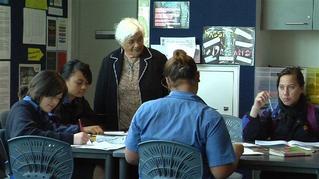Online Teaching and learning using multimedia
https://www.youtube.com/watch?v=7uBzK14C7Sk
<iframe width="420" height="315" src="http://www.youtube.com/embed/7uBzK14C7Sk" frameborder="0" allowfullscreen></iframe>
Although this video is about children, it can also be applied to adults.
2 March 2012
Teaching strategy using technology
Online teaching and learning using multi-media can be very successful providing that there is access to computers and adequate networks such as internet connection in the community for the service provided.
It is important to understand the phenomena of online teaching and learning and to examine the various techniques, methods and approaches that can be used. Online is a tool that assists certain learners that have opted to do a particular course in their own time and at their own convenience. These online learners take responsibility for their own learning.
Online teaching and learning enhances participation, it is student centered, and it challenges and motivates students to discover information they need for their course of study and keeps the students in control of their own learning although these students have to be very disciplined and goal-directed.
It is imperative to understand the online learner’s needs. The students need clear guidance and instructions because everything is in written form and words should be used effectively. They also need social interaction and this can become meaningful through discussion boards and emailing those participating in the same course.
With these needs in mind, various techniques, methods and approaches can be implemented. Presentation graphics packages such as PowerPoint are annotated with streaming audio but could lack in-depth content. However slide shows has the ability to stimulate thought and inquiry learning.
Computer-animated simulations can also add profundity to the lesson because it not only draws attention makes one associate it to a situation and is more conducive to learning. Many students think and process information differently and computer-animated simulations may evoke thoughts from different perspectives.
The social context, involving social relationships and digital technologies, can induce intended and unintended consequences and can affect student learning. It is also stated that “cultural contexts shape the meaning, conduct and outcomes of teaching and learning with digital technologies” (cited in Benson, D. (2002) p141). Digital technology does incorporate good pedagogical practice principles of active learning and collaborative learning.
Computer-mediated methods such as Web-based discussion boards may encourage students who do not actively engage and participate in face-to-face discussions to participate actively in computer-mediated discussions.
Some theorists (Greenlaw, 1999:34, Bonk and Cummings 1998) acknowledge improvement when students write assignments because careful research is done and the text reflects insight that is carefully executed.
The teaching and learning process in programme design using digital technology faces various challenges when trying to accommodate diverse learning styles and learners from different cultures yet still providing sufficient content. Benson, D. (2002) uses the analogy of “inverting the classroom”. Therefore by using digital technologies, it tries to enable this diverse culture to view or hear artefacts by using a menu option on the computer screen.
In the multimedia classroom, computers and audio visual material is used however one wonders about technology problems that could arise and how it affects the teaching and learning process. Another concern is that of age, race and ethnicity, the marginalised group, and rural or urban locality which Benson, D (2002, p. 145) calls the “digital divide”.
Reference:
Benson, D. (2002). Digital technologies and the scholarship of teaching and learning in sociology.
Teaching Sociology, 30, 140-157.
Greenlaw, S. (1999). Using groupware to enhance teaching and learning in undergraduate
economics. Journal of Economic Education. 30 (1), 33-42.

I am going to review and re-write my blog as I feel I have tried to cover everything in a single post and mention ever aspect of online learning. I feel I rather need to go into depth in a single topic and cover various aspects in future blogs.
ReplyDeleteHi Ethni
Deleteyour reflection is interesting and you make a good point on perhaps not covering too wide an area but rather to go into more depth. Using a limited range of references can also lead to generalisations- by that I mean you say in your blog that Online learning is student centered and adds challenge- I question this as I would say that if an online paper is just a replica of a f2f class with some information in documents etc and powerpoints added then it would not be any more student centered than other forms of teaching. It is the design of the Online paper that makes it challenging etc no the fact it is Online.